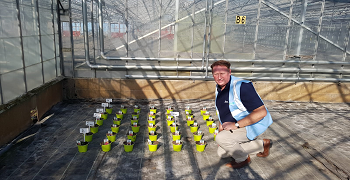Skilled nurseryman Carl Mason has 25 years’ experience of trialing and working with peat reduced growing media in pot and bedding production. Indeed, early on in his career he was involved in some of the earliest peat reduced trials. Now - in his new role as ICL Technical Area Sales Manager for Lincolnshire, Nottinghamshire and Yorkshire - he is putting this knowledge and practical experience to good use advising growers on the practicalities of raw materials used in their growing media.

ICL's Carl Mason
As we are all aware, peat usage remains on the radar of most retailers and the Government, who want professional growers to reduce the amount being used worldwide. The challenge to find alternative products to replace the peat in professional growing media by 2030 have been passed down the supply chain. Most leading European growing media manufacturers already employ many different products to reduce the amount of peat used.
Twenty-five years ago, I worked for a large bedding grower in Lincolnshire, where the owner’s father was a world-leading horticultural consultant. With the foresight to see the likely challenges with regard to peat usage that lay ahead, the decision was made to try coir as a way to reduce peat usage in the packs.
We started trials at 5% coir, then 10% and moved up to 15% in the mix. At this higher rate there was no difference to the plant quality, but the growing media didn’t look as good in the packs. We therefore ran with a 10% mix of coir, which worked really well for us. It flowed through the machines well and transplanting was good. The most interesting part was the coir acted as buffer for water, while also helping to break the surface tension when watering, without locking up the nutrients. This changed the way we grew the plants without compromising the quality of the crop and giving us a great selling point.
At this time, we also tried many other materials including wood bark, wood chip and, believe it or not, recycled landfill material! Some were highly successful and others not so great.
Some of these products gave us lots of issues in filling the packs and pots, issues with planting and problems with how it looked and performed. We trialed mixes over a couple of years to see how everything worked, or in some cases didn’t.
Some of the problems were due to sustainability and consistency of the product and whether or not it was a constant grade. This is why peat was always going to be the best all round growing media, which then could be blended to produce different structures for most plants.
Fast-forward 20 years and everything has moved on a great deal. We now have a far better understanding of the effects of different raw materials when mixed with peat. There is also an array of different products, such as Osmocote controlled release fertilizers and H2Gro water management technology, that can be added to the growing media to improve plant quality and make growing easier.
Before joining ICL in 2018, I worked for another large Lincolnshire pot and bedding plant producer. Our peat-reduced Levington Advance bedding mix contained 10% coir and 15% fibagro. It was great for free flowing through the machines and transplanters, and most of all good for growing in.
By incorporating these peat diluents, the growing media structure became more open, which gave us greater free air space and made wetting and drying out more even. And, by adjusting the nutrient level we grew a full range of bedding plants in a single mix by just topping up with liquid feed as and when the plant or customer demanded it.
This helped us produce great crops from seedlings and cutting raised plants, to the final saleable product, with the benefit of knowing we were reducing our peat usage.
Today growing media mixes can be tailored specifically to what the grower, or indeed the retailer, wants. With a wealth of knowledge, ICL’s skilled technical sales team is here to work with growers to produce mixes tailored to crops which will perform well with customer’s growing techniques.
